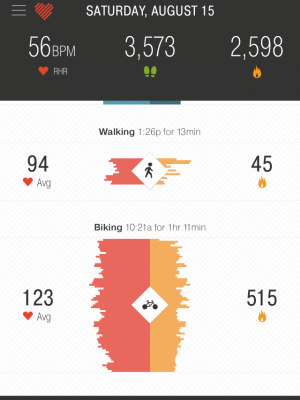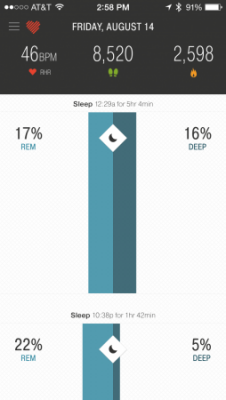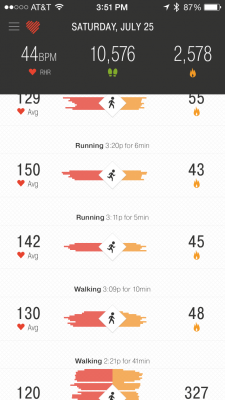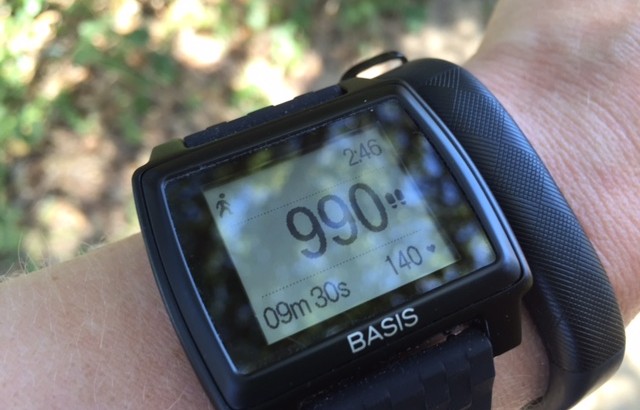Quick Recap
– Solid Pulse Tracking
– Informative Resting Heart Rate
– Realistic Calorie Estimates
– Very Useful Visible Display
– Luxury Comfort
– Biking Autodetect
– Disjointed Data
– Large, Masculine Form Factor
– Overestimated Sleep Duration
| Fitness: |
| Sleep: |
Read on to see Highlights of the Basis Peak, Areas for Improvement, and Comparing the Basis to Competitors.
Highlights of the Basis Peak
– Solid Pulse Tracking
The Basis Peak does a good job tracking resting heart rate and steady-state cardio activities, like walking and running. And while it’s not perfect with burstier activities, it is the most accurate wrist-based pulse tracker I’ve yet tried. Where wrist pulse trackers traditionally fall short is in the strength training & bursty activity arena – they just don’t pick up quick fluctuations in heart rate well. The Basis user manual explicitly lists a handful of activities which it does not track well. Serious kudos to Basis for actually acknowledging their hardware’s limitations. Full disclosure is rare and refreshing in the world of wearables marketing.
Here’s an example of my heart rate tracked by 3 different devices on a hike. This shows the disparity between the different devices. The chest strap is the most accurate. Hiking is a bursty activity, where heart rate goes up and down quickly as the terrain changes. And though wrist pulse trackers can miss the spikes, the Basis performed pretty well.
| device | reading location | max heart rate (15 minute climb) | average heart rate | estimated calories burned |
|---|---|---|---|---|
| Polar FT4 Heart Rate Monitor | chest strap | 171 bpm | 112 bpm | 525 cal |
| Basis Peak | wrist pulse | 160 bpm | 119 bpm | 671 cal |
| Fitbit Charge HR | wrist pulse | 84 bpm | 66 bpm | 768 cal (set by linked MyFitnessPal account) |
– Informative Resting Heart Rate
I find the Basis resting heart rate (RHR) information incredibly interesting. There’s a very clear correlation between the quality of my sleep and my resting heart rate. My daily RHR goes up and down anywhere from 44-56 beats per minute, depending on my sleep, stress, and other factors I’m still discovering. I know I have a generally low heart rate, both from genetics and exercise, but tracking the daily fluctuations is shining new light on how particular events impact my heart.
Side note: The first day I wore the Fitbit Charge HR, it started with an RHR of 45, in line with the Basis. Everyday thereafter, the number rose and rose, linearly, until it was in the 60s and still climbing by the time I stopped wearing it. This number didn’t mesh with years of HR readings, nor other devices I compared it to directly. But more importantly, I could not derive any meaning from the fact that it just went up continuously. Seeing the Basis’s data fluctuate in comparison, I can now truly appreciate the value of monitoring RHR, since I can readily see the correlation between life events and how they impact heart rate.
– Realistic Calorie Estimates
– Very Useful Visible Display

– Luxury Comfort
From the time you open the packaging (which feels like opening an expensive watch) to the point you put the Basis on your wrist, every moment is comfortable. The lining 7of the wrist band is luxurious, a silky yet somehow sweat-resistant material that just feels good on your skin.
I was worried the device might irritate my sensitive skin after a sustained period, but it hasn’t. I sometimes have to loosen it during arm-intensive exercise like weight-lifting or biking, but that is totally reasonable.
– Biking Autodetect
Here my Basis detected that I walked in the afternoon, biked in the morning.

Areas for Improvement with the Basis Peak
– Disjointed Data
My biggest complaint about the Basis is that it breaks fitness and sleep down into segments and lists them individually rather than summarizing them more intuitively.
 |
 |
| On this night, Basis decided I slept in 2 parts. Sometimes it’s 3 or 4. Maybe I pee, maybe I turn over, but for me, it is one night’s sleep. Yet Basis offers no consolidated view of my overall sleep duration or quality. This is the norm for me. Clearly they don’t know about second sleep. | Here, I took a hike and broke into a jog at a few points. Basis split this hike into 5 different segments. On the upside, I can see the totals for the day in the black band at the top. On the downside, there is no total for just “the hike”. I have to do manual calculations to derive those stats. |
I can see how breaking the data up makes sense to an engineer – the raw data has different patterns in it. But to a human, this is not logical. I slept ONCE. I hiked ONCE. I want a summary of each one, not 5 different charts. Note: Apparently the Basis website does summarize daily sleep duration, but the primary mobile app interface does not.
– Large, Masculine Form Factor

– Overestimated Sleep Duration
Overestimating the length of a night’s sleep is a problem across the board with ALL passive sleep trackers, including the Basis. Any sedentary evening or morning activity gets lumped into sleep. This is the tradeoff for not having to manually track sleep. For now, passive data collection means less accurate data.
I frequently read at night, sometimes for hours. This is not sleep – I am awake and accomplishing something. Last week, Basis reported that I slept up to 11.5 hours a night because of this, when the real max was under 8.25 hours. Basis does a significantly better job of autodetection on nights when I don’t read or relax before bed, but since that’s sporadic, my sleep data is generally unreliable.
Side note: Jawbone has maintained a partially manual sleep function, which in fact makes it the most accurate. You can press a button when you get into bed to enter sleep mode, but if you forget or choose not to, the Jawbone still autodetects your sleep passively. The difference is that you actually have to review (and optionally correct) the autodetected sleep duration before it will show up in your daily activity. This is a really simple process, and merely by adding this trivial review step, the Jawbone data becomes exceedingly more accurate.
I’d rather have correct data than a completely passive device.
Comparing the Basis to Competitors
Sleep Comparison
| Feature | Basis Peak | Fitbit Charge HR | Jawbone Up2 | Misfit Flash |
|---|---|---|---|---|
| Count awakenings/ interruptions | ||||
| Count toss/turns | ||||
| Light sleep | ||||
| Deep sleep | ||||
| REM sleep | ||||
| Sleep duration | ||||
| Time awake in bed | ||||
| Time to fall asleep | ||||
| Sleep quality score | ||||
| weekly sleep summary email | ||||
| Feature | Basis Peak | Fitbit Charge HR | Jawbone Up2 | Misfit Flash |
| Deep sleep range | 15-30% for me | unavailable | 30-75% for me | 15-65% for me |
| Tracking style | Passive | Passive | Part Passive, Part Manual | Passive, editable |
| Price class | higher end | mid | mid | budget |
| Sleep Duration Accuracy | ** | |||
| Overall Sleep Usefulness | * |
**deducted 1 star because of Jawbone bugs
I’ve found that Sleep Duration and Awakenings are the 2 most reliable indicators of sleep quality. You don’t really need a device to tell you that you woke up in the night though, unless you unknowingly suffer from sleep apnea.
Fitness and Function Comparison
Here’s a comparison of the devices I’ve used recently, in terms of fitness and non-sleep functionality.
| Feature | Basis Peak | Fitbit Charge HR | Jawbone Up2 | Misfit Flash | |
|---|---|---|---|---|---|
| wrist interface | smart watch with touch screen | button to cycle through stats | tap to toggle sleep/wake mode, no other display | current time and daily progress % | |
| battery life | 4-5 days | 7 days | 9-10 days | 8 months | |
| activity autodetect | walk, run, bike | walk, run | walk, run | walk, run | |
| Feature | Basis Peak | Fitbit Charge HR | Jawbone Up2 | Misfit Flash | |
| Challenges (individual or social) | |||||
| pulse tracking | not this model | not this model | |||
| swim tracking (waterproof) | |||||
| rich mobile app | |||||
| rich website | |||||
| weekly step summary email | |||||
| data export | |||||
| Feature | Basis Peak | Fitbit Charge HR | Jawbone Up2 | Misfit Flash | |
| customizable goals | yes | yes | yes | partial (presets) | |
| notification when daily activity goal hit | text alert | vibration & lights | vibration & lights | lights | |
| Unique Features |
|
|
|||
| Step Tracking Accuracy | |||||
| Strength/ Bursty Activity Tracking | |||||
| Overall Fitness Usefulness |
* “Habits” are behaviors encouraged by the Basis app, such as walking at different times of the day (“Afternoon Lap”, “Morning Lap”), standing up and moving periodically (e.g. every 1 hour) to be less sedentary, hitting a certain level of activity or calories a certain number of times per week. These are all user-configurable and sound very promising in theory. But there are significant design issues still to be resolved to make them actually useful. For example, there is no inactivity alert to tell you that you haven’t stood up in an hour, despite the fact that the device is measuring this and knows that you’ve configured a Habit because you want to do it. For some Habits, there are sporadic reminders that come at odd times. I got a reminder to take an Afternoon Lap shortly after a 10,000 step hike. The potential for this feature is really great, it just needs some more work.
As you probably noticed, I’m currently wearing both the Basis Peak and the Jawbone Up2 on my wrist these days. That’s because each of them does some things really well that the other doesn’t do. I love them both in their own ways. As with all wearables, a simple software update can make a huge difference and it can come at any time. The only thing that can’t be improved via software is the form factor. I eagerly look forward to the future of Basis updates, to see what they next have in store for this device.
